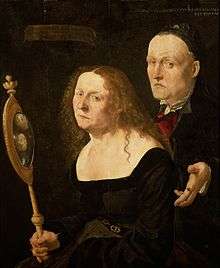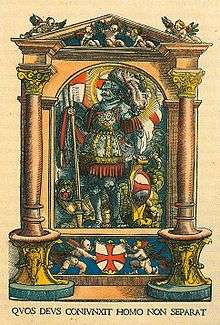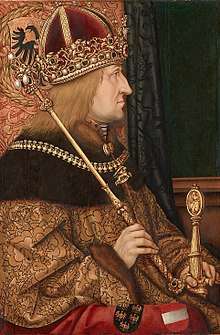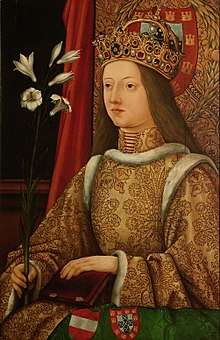Hans Burgkmair
Hans Burgkmair the Elder (1473–1531) was a German painter and woodcut printmaker.
Hans Burgkmair | |
|---|---|
 The painter Hans Burgkmair and his wife Anna (painting by Lukas Furtenagel, 1529) | |
| Born | 1473 Augsburg, Germany |
| Died | 1531 (aged 57–58) Augsburg, Germany |
| Nationality | German |
| Known for | Painting, printmaking, woodcut |
Life
Hans Burgkmair was born in Augsburg, the son of painter Thomas Burgkmair. His own son, Hans the Younger, later became a painter as well.[1] From 1488, Burgkmair was a pupil of Martin Schongauer in Colmar. Schongauer died in 1491, before Burgkmair was able to complete the normal period of training. He may have visited Italy at this time, and certainly did so in 1507, which greatly influenced his style. From 1491, he worked in Augsburg, where he became a master and eventually opened his own workshop in 1498.
German art historian Friedrich Wilhelm Hollstein ascribes 834 woodcuts to Burgkmair, the majority of which were intended for book illustrations. Slightly more than a hundred are “single-leaf” prints which were not intended for books. His work shows a talent for striking compositions which blend Italian Renaissance forms with the established German style.
From about 1508, Burgkmair spent much of his time working on the woodcut projects of Maximilian I until the Emperor's death in 1519.[1] He was responsible for nearly half of the 135 prints in the Triumphs of Maximilian, which are large and full of character. He also did most of the illustrations for Weiss Kunig and much of Theurdank. He worked closely with the leading blockcutter Jost de Negker, who became in effect his publisher.[2]

He was an important innovator of the chiaroscuro woodcut, and seems to have been the first to use a tone block, in a print of 1508.[3] His Lovers Surprised by Death (1510) is the first chiaroscuro print to use three blocks,[4] and also the first print that was designed to be printed only in colour, as the line block by itself would not make a satisfactory image. Other chiaroscuro prints from around this date by Baldung and Cranach had line blocks that could be and were printed by themselves.[5] He produced one etching, Venus and Mercury (c1520),[6] etched on a steel plate, but never tried engraving, despite his training with Schongauer.
Burgkmair was also a successful painter, mainly of religious scenes, portraits of Augsburg citizens, and members of the Emperor's court. Many examples of his work are in the galleries of Munich, Vienna and elsewhere.[7]
Burgkmair died at Augsburg in 1531.
Gallery


 Print in the Triumphs of Maximilian
Print in the Triumphs of Maximilian Altarpiece by Burgkmair (Alte Pinakothek)
Altarpiece by Burgkmair (Alte Pinakothek)
See also
Notes
- Gietmann 1908.
- Landau & Parshall, 212
- "Emperor Maximilian on Horseback". Artbma.org. Archived from the original on 2007-01-06.
- "Lovers Surprised by Death".
- The Renaissance Print, David Landau & Peter Parshall, Yale, 1996, ISBN 0-300-06883-2
- "Hans (the Younger) Burgkmair". Artnet.de.
- Chisholm 1911.
References


External links

- Burgkmair's Flodden woodcut
- Prints & People: A Social History of Printed Pictures, an exhibition catalog from The Metropolitan Museum of Art (fully available online as PDF), which contains material on Burgkmair (see index)